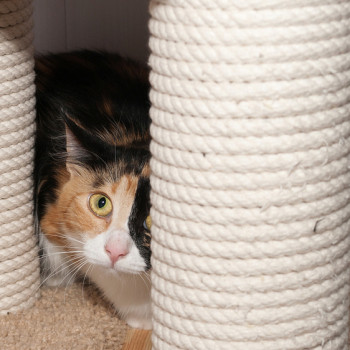The best way to help any cat entering an animal shelter will depend on the cat. Unfortunately, it can be difficult for many shelter workers to tell the difference between a cat who is a social animal, used to humans, but severely stressed out or afraid, and a truly feral cat.
Sara L. Bennett, DVM, MS, DACVB, a past animal behavior resident sponsored by the Maddie’s® Shelter Medicine Program at Purdue University and a Diplomate of the American College of Veterinary Behaviorists, presented “Distinguishing Feline Behaviors in Shelters: Stressed, Fearful, or Feral?” at the 2015 North American Veterinary Community Conference.
In her presentation, Dr. Bennett told attendees that entering a shelter triggers stress and fear in all cats, even those who are social and used to humans. And while fear responses in and of themselves don’t vary between fearful social cats and fearful feral cats, cats that were previously social with people show a reduction in signs of fear over time. From the presentation proceedings (paragraph breaks added to improve readability):
[U]sing a series of standardized interactions… (researchers) found an increase over time in affiliative, friendly, or social behaviors in cats that had a higher level of socialization. They also found that evaluating these cats the morning of the day after intake (Day 2 AM) and the morning of the next day (Day 3 AM) gave good predictions to identify cats with more socialization.
Behaviors used included the presence of any one of the following: rub, knead, touch, play, at the front of the cage, chirp and tail up; or four or more of any of the following: sniff, roll, reach, approach front of cage, yawn, groom/ shake, and standing or still moving at the end of the assessment.
One of the goals of this series was to create a tool that would help to differentiate less socialized fearful cats from unsocialized feral cats since this historically is the most challenging group to differentiate. This is a very important delineation to make as quickly as possible because the extreme stress a feral cat in captivity faces will have a dramatic impact on his behavioral and physical heath and is a major welfare concern. Their time in captivity must be kept as short as possible with as minimal handling as possible.
Additionally, the very fearful shy but socialized cat’s welfare can also suffer significantly if not recognized. Steps should be taken to monitor their stress level, behavioral and physical health so that adjustments in the environment such as a quieter areas and interactions only with a consistent handler or being moved to foster can be made.
VetFolio subscribers can access the complete proceedings of Dr. Bennett’s presentation here; notes are also available on the website of the Indiana Veterinary Medical Association.
Also of interest:

